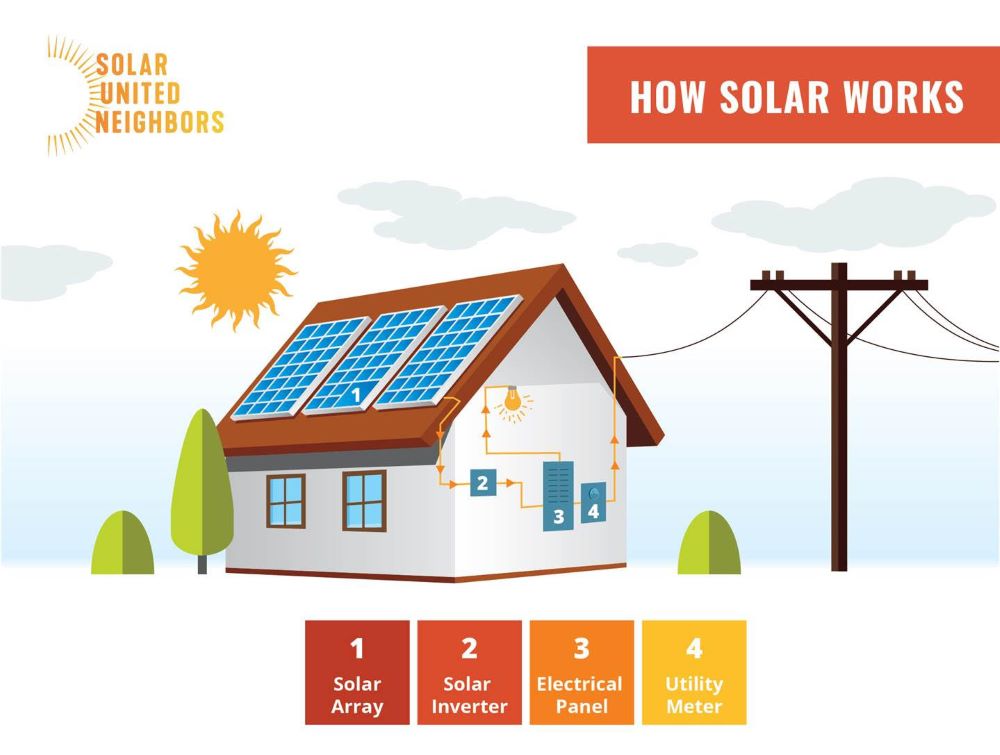Be your own power source with rooftop solar

If you want to create clean, renewable, local power right at home, going solar is a good option! That’s why Hennepin County and the State of Minnesota have goals of meeting 10% of our energy needs by on-site solar by 2030.
Even though on-site solar is a powerful and increasingly affordable climate solution, figuring out how to go solar at home can feel overwhelming. Putting solar panels on your house is a commitment, and it takes time to see a return on investment.
Good news is that with a few tips, you can quickly refine your research and figure out if solar is a good fit for your home and environmental goals.
How it works

Here is an overview of how solar panels create energy at your home.
- A group of solar panels wired together is called an array. The solar arrays you see on homes today use solar photovoltaic (PV) technology that converts sunlight to electricity.
- The energy from the array flows to an inverter. This is a piece of equipment that converts the direct current (DC) created by the solar array into alternating current (AC), which is what is used in your home.
- AC flows from the inverter into your home’s electrical panel and powers your home’s electronic appliances and electronic devices.
- Your home uses as much energy as it needs, and then the solar arrays’ excess energy flows out through your home’s utility meter and into the electrical grid. Since electricity seeks the closest draw, it is then used by your neighbors.
With a solar array, your home is connected to the electrical grid just as you are now, and you will use as much grid-sourced power as you need. When you produce more than you can use, the renewable solar power travels onto the grid, and you get paid for it!
If the grid power goes down, so does your home energy solar system. This is a safety feature so the electricity from your array does not harm line workers as they work to restore power. Solar panels produce energy, but they don’t store energy. If you want your own back-up energy storage, you’ll need to invest in a battery storage system.
Selecting the right solar installer for you
Finding the right solar installer will be key to a good experience in going solar. Installing solar panels and connecting them to the grid requires the expertise of a solar installer, so take the time to find a credible one. Preferably, work with based in Minnesota so you can easily contact them if something needs fixing.
Fortunately, we have many reputable local installers in Minnesota. Get bids and references from at least three different installers. The bids should include system type and size, expected energy production, maintenance, warranties, and the cost to install.
Here are some resources to find installers:
- Minnesota Clean Energy Resource Teams (CERTs)
- Minnesota Solar Energy Industries Association (MnSEIA)
Be sure that the contract with your installer has your final payment due only once your solar array is successfully hooked to the grid and operational. Avoid installers with aggressive sales techniques and be wary of installers who are overly eager to steer you to their in-house financing. Find an installer that communicates well with you and responds to your questions.
Solar United Neighbors is a nonprofit focused on solar that can help review your solar proposals. Learn more about Solar United Neighbors' go solar on your own resources.
Incentives to make solar more possible
The Federal Solar Investment Tax Credit is available to anyone who installs rooftop solar. The credit is currently equal to 26% of the cost of the solar array.
A tax credit is a dollar-for-dollar reduction in the income taxes that you would otherwise pay the federal government. If you don’t use all the tax credit in one year, you can roll it over to the next tax year. Keep in in mind that for those with a lower income and a small tax burden, this incentive might not be valuable.
Some cities and electric utilities offer other incentives. A local installer should be familiar with what is available to you and how they work. There is also financing designed for installing solar that can be helpful.
Here are two sites to find out what is available:
- Database of State Incentives for Renewables & Efficiency
- Solar United Neighbors: Minnesota Solar Incentives
The 2022 Inflation Reduction Act (IRA) carries a host of tax credits and discounts on everything from electric cars to solar energy. Depending on location and income, American households can qualify for up to $10,000 - or more - in tax breaks and rebates. Use the IRA Calculator to better understand what rebates and tax credits you may qualify for.
The cost and return on investment
If you’re planning to stay in your home for several years, you will enjoy a return on your solar array investment. Solar arrays require little maintenance and will last for 25 years or more.
A typical solar panel has a production warranty of 25 years. Once the cost of the system is recovered through energy savings and incentives, you’ll be making a profit from the remaining life of your solar array.
In their bid, a solar installer will include a proposal for what your payback period will be. That is, how long it will take to get a return on your initial investment. Review the assumptions they make in their analysis and ask them to adjust any that seem too optimistic to you.
Example proposal
Here is an example of what proposal from an installer might look like. Note: This simplified example doesn’t account for the increasing cost of electricity but gives you an idea of how to think through the payback period for your solar array.
Let’s assume you are installing a 5-kilowatt system that costs $15,000:
- The Federal Solar Investment Tax Credit would be 26% of that and equal to $3,900.
- The estimated annual production of this system is 6,572-kilowatt hours (kWh), which is worth about $755 a year (electricity estimated at $.115 a kWh).
- You qualify for the Xcel Solar*Rewards® incentive, which pays $0.07 a kWh for the solar energy produced for 10 years. That would be another $460 a year (6,572 kWh x $.07).
- The net cost of the system is $11,100 (cost of system minus the Federal Solar Investment Tax Credit).
- The annual value of the electricity produced added to the incentives is $1,210 ($755 + $460). Divide this into the net cost of $11,100 and you get a payback period of 9 years and 2 months.
Seek out help from nonprofits with expertise
There are non-profits that focus on solar and can help you navigate the process. Use them to make the process easier.


